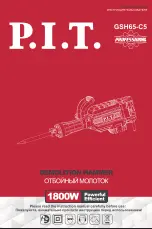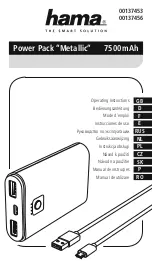
-42-
Model W1680 (For Machines Mfd. Since 06/22)
SE
RV
IC
E
Operation
PROBLEM
POSSIBLE.CAUSE
CORRECTIVE.ACTION
Tool falls out or
loose in chuck.
1. Chuck jaws loose.
2. Excessive feed pressure.
1. Tighten chuck jaws.
2. Decrease feed pressure and allow chips to clear.
Chuck and arbor
fall out or loose
in spindle.
1. Debris on chuck, arbor, or in spindle taper.
2. Excessive feed pressure.
1. Clean chuck, arbor, and spindle taper, then re-install
(
Pages 19 and 26).
2. Decrease feed pressure and allow chips to clear.
Breaking tools or
cutters.
1. Spindle speed/feed rate too fast.
2. Taking too big of cut at one time.
3. Improper cutting technique or type of cut for
tool/machine.
4. Cutting tool too small.
5. Cutting tool getting too hot.
6. Spindle extended too far down during or at
beginning of operation.
1. Reduce spindle speed (
Page 30); reduce feed rate.
2. Decrease feed pressure and allow chips to clear.
3. Use right technique or machine for job.
4. Use larger cutting tool and slower feed rate.
5. Use coolant or oil for appropriate application;
reduce cutting speed (
Page 30).
6. Fully retract spindle and raise table to increase
rigidity.
Workpiece or
tool vibrates or
chatters during
operation.
1. Spindle extended too far down during or at
beginning of operation.
2. Table locks not tight.
3. Workpiece not secure.
4. Spindle speed/feed rate too fast.
5. Quill shaft lock screw not adjusted correctly.
1. Fully retract spindle and raise table to increase
rigidity.
2. Tighten table locks (
Page 29).
3. Properly clamp workpiece on table or in vise.
4. Reduce spindle speed (
Page 30); reduce feed rate.
5. Adjust quill shaft screw (
Page 40).
Table hard to
move.
1. Table locked.
2. Dirty or dry rack and pinion.
1. Disengage table locks (
Page 29).
2. Clean away chips/debris. Lubricate rack and pinion
(
Page 37).
Bad
surface finish.
1. Spindle speed/feed rate too fast.
2. Dull or incorrect cutting tool/bit.
3. Workpiece not secure.
4. Spindle extended too far down during or at
beginning of operation.
1. Reduce spindle speed (
Page 30); reduce feed rate.
2. Sharpen cutting tool or select one that better suits
the operation.
3. Properly clamp workpiece on table or in vise.
4. Fully retract spindle and raise table to increase
rigidity.
Spindle
overheats.
1. Machine operated at high speeds for extended
period.
1. Allow drill to cool.
Spindle does not
fully retract.
1. Poorly adjusted return spring.
2. Debris on spindle/quill rack.
3. Worn return spring.
1. Increase return spring tension (
Page 39).
2. Clean and lubricate spindle/quill rack (
Page 37).
3. Replace return spring.
Drill bit drifts.
1. Dull/incorrectly sharpened drill bit.
2. Tool/bit/chuck incorrectly installed.
1. Correctly sharpen drill bit.
2. Correctly re-install tool/bit (
Page 28)/chuck
(
Page 19).
Drill bit slips in
chuck or stuck in
workpiece.
1. Chuck jaws loose.
2. Workpiece squeezing drill bit, or feed rate
too fast.
3. Spindle speed/feed rate too slow.
1. Tighten chuck jaws.
2. Properly clamp workpiece on table or in vise;
decrease feed rate.
3. Increase spindle speed (
Page 30); increase feed
rate.
Workpiece
thrown from
table.
1. Workpiece not secure; tool/bit too large for
feed speed.
1. Properly clamp workpiece on table or in vise.
Excessive runout
or wobbling in
chuck/drill bit.
1. Debris between chuck-to-arbor mating
surface.
2. Tool/bit bent.
3. Tool/bit installed incorrectly.
4. Spindle bearings worn.
1. Remove chuck, clean, deburr tapered chuck and
arbor mating surfaces, reassemble (
Pages 26).
2. Replace with straight tool/bit.
3. Install tool/bit correctly (
Page 28) or replace.
4. Replace spindle bearings.
Backside of
workpiece
splinters.
1. Scrap board not installed between table and
workpiece.
1. Install scrap board between table and workpiece.









































